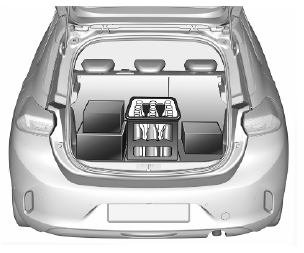Opel Corsa: Storage / Loading information

- Heavy objects in the load compartment should be placed against the seat backrests. Make sure that the backrests are securely engaged. If objects can be stacked, heavier objects should be placed at the bottom.
- Prevent sliding of loose objects by securing them with straps attached to the lashing eyes.
- Do not allow the load to protrude above the upper edge of the backrests.
- Do not place any objects on the load compartment cover or the instrument panel, and do not cover the sensor on top of the instrument panel.
- The load must not obstruct the operation of the pedals, parking brake and gear selector, or hinder the freedom of movement of the driver. Do not place any unsecured objects in the interior.
- Do not drive with an open load compartment.
Warning
Always make sure that the load in the vehicle is securely stowed. Otherwise objects can be thrown around inside the vehicle and cause personal injury or damage to the load or car.
- The payload is the difference
between the permitted gross
vehicle weight (see identification
plate) and the EC kerb
weight.
To calculate the payload, enter the data for your vehicle in the weights table at the front of this manual.
The EC kerb weight includes weights for the driver (68 kg), luggage (7 kg) and all fluids (fuel tank 90% full).
Optional equipment and accessories increase the kerb weight.
- Driving with a roof load increases
the sensitivity of the vehicle to
cross-winds and has a
detrimental effect on vehicle
handling due to the vehicle's
higher centre of gravity.
Distribute the load evenly and secure it properly with retaining straps. Adjust the tyre pressure and vehicle speed according to the load conditions. Check and retighten the straps frequently.
Do not drive faster than 120 km/h.
The permissible roof load is 70 kg. Do not exceed a loading height of 40 cm. The roof load is the combined weight of the roof rack and the load.
 Roof rack system
Roof rack system
Roof rack
For safety reasons and to avoid
damage to the roof, the vehicle
approved roof rack system is
recommended. For further
information, contact your workshop...
Other information:
Opel Corsa 2020-2025 Owners Manual: Turn lights. Seat belt reminder
Turn lights illuminates or flashes green. Illuminates briefly The parking lights are switched on. Flashes Turn lights or the hazard warning flashers are activated. Rapid flashing: failure of a turn light or associated fuse, failure of turn light on trailer. Seat belt reminder illuminates or flashes red in the instrument cluster together with the indication in the roof console for each sea..
Opel Corsa 2020-2025 Owners Manual: Exterior mirrors
Convex shape The shape of the mirror makes objects appear smaller, which will affect the ability to estimate distances. Electric adjustment Select the relevant exterior mirror by pushing to the left or right. Then swivel the control to adjust the mirror. Folding mirrors For pedestrian safety, the exterior mirrors will swing out of their normal mounting position if they are struck with s..
Categories
- Manuals Home
- 6th Generation Corsa Owners Manual
- 6th Generation Corsa Service Manual
- Operation with the key in case of a central locking system fault
- Activation of the functionality
- Driving time alert
- New on site
- Most important about car

